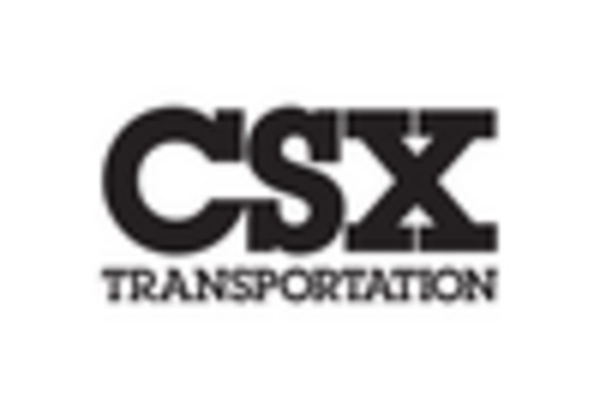Market Growth Projections
The Global Rail Freight Transport Market Industry is poised for substantial growth in the coming years. With a projected market value of 1561.6 USD Billion in 2024, the industry is expected to expand further, reaching 2125.4 USD Billion by 2035. This growth trajectory suggests a compound annual growth rate (CAGR) of 2.84% from 2025 to 2035. Factors contributing to this growth include increasing demand for efficient freight transport solutions, technological advancements, and government support for rail infrastructure development. As the market evolves, it is likely to adapt to emerging trends and challenges, positioning itself as a vital component of the global logistics landscape.
Expansion of Intermodal Transportation
The Global Rail Freight Transport Market Industry is benefitting from the expansion of intermodal transportation networks. Intermodal transport, which combines rail with other modes such as trucking and shipping, enhances the efficiency and flexibility of freight movement. This integration allows for seamless transitions between different transport modes, reducing transit times and costs. For instance, the establishment of dedicated intermodal terminals facilitates quicker loading and unloading processes. As a result, the market is expected to grow steadily, with projections indicating a value of 2125.4 USD Billion by 2035, driven by the increasing reliance on intermodal solutions.
Government Initiatives and Investments
Government initiatives and investments are crucial drivers of the Global Rail Freight Transport Market Industry. Many countries are recognizing the strategic importance of rail freight in enhancing trade and economic growth. As a result, governments are investing in upgrading rail infrastructure, expanding networks, and providing financial incentives for rail operators. For example, initiatives aimed at improving rail connectivity in emerging economies are expected to stimulate market growth. These investments not only enhance the capacity and efficiency of rail systems but also promote competitiveness in the logistics sector, thereby supporting the overall growth trajectory of the market.
Rising E-commerce and Consumer Goods Demand
The Global Rail Freight Transport Market Industry is significantly influenced by the rising demand for e-commerce and consumer goods. As online shopping continues to proliferate, the need for efficient and reliable freight transport solutions becomes paramount. Rail freight offers a cost-effective means of transporting large volumes of goods over long distances, making it an attractive option for e-commerce companies. The increasing reliance on rail for the movement of consumer goods is expected to drive market growth, with projections indicating a market value of 1561.6 USD Billion in 2024. This trend underscores the critical role of rail freight in supporting the logistics needs of the modern economy.
Technological Advancements in Rail Infrastructure
Technological advancements play a pivotal role in the Global Rail Freight Transport Market Industry. Innovations such as automated train operations, predictive maintenance, and advanced signaling systems enhance operational efficiency and safety. These technologies not only reduce operational costs but also improve service reliability, which is crucial for meeting the demands of modern supply chains. The integration of big data analytics allows for better route optimization and resource allocation. As these technologies continue to evolve, they are likely to attract further investments, contributing to the market's projected CAGR of 2.84% from 2025 to 2035.
Increasing Demand for Sustainable Transport Solutions
The Global Rail Freight Transport Market Industry is experiencing heightened demand for sustainable transport solutions. As global awareness of environmental issues rises, rail freight is increasingly viewed as a greener alternative to road transport. Rail systems emit significantly lower greenhouse gases per ton-mile compared to trucks, making them a preferred choice for companies aiming to reduce their carbon footprints. This shift is reflected in the growing investments in electrification and the adoption of energy-efficient technologies within the rail sector. Consequently, the market is projected to reach 1561.6 USD Billion in 2024, indicating a robust response to sustainability imperatives.

















Leave a Comment